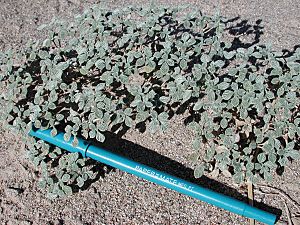Fanleaf crinklemat facts for kids
Quick facts for kids Fanleaf crinklemat |
|
|---|---|
 |
|
| leaves averaging 3/8 inches | |
| Conservation status | |
| Scientific classification | |
| Genus: |
Tiquilia
|
| Species: |
plicata
|
| Synonyms | |
|
Coldenia plicata |
|
The Fanleaf Crinklemat (also known as Tiquilia plicata) is a fascinating plant found in the deserts of the southwestern United States and northwestern Mexico. It's a type of perennial plant, which means it lives for more than two years. It's also a subshrub, meaning it's a bit like a small bush. This plant is usually quite short, growing to about 12 inches (30 cm) tall.
Contents
Discovering the Fanleaf Crinklemat
The Fanleaf Crinklemat is a unique desert plant. It's known for its small, crinkly leaves and pretty flowers. This plant is well-adapted to living in dry, hot places.
Where Does the Fanleaf Crinklemat Grow?
You can find the Fanleaf Crinklemat in lower elevation deserts. It lives in parts of the southwestern United States and northwestern Mexico. Specifically, it grows in the states of California, Nevada, and Arizona in the U.S. In Mexico, it's found in Sonora and Baja California. It's a true desert survivor!
What Does the Fanleaf Crinklemat Look Like?
This plant is quite small and low-growing. It usually doesn't get taller than 12 inches (about 30 centimeters).
Its Unique Leaves
The Fanleaf Crinklemat has small leaves that are shaped like an oval. They are usually less than 1/2 inch (about 1.2 cm) long. The leaves are special because they are "crinkly" with ridges, almost like they've been folded. This is how the plant gets part of its common name, "crinklemat."
Its Pretty Flowers
The flowers of the Fanleaf Crinklemat are very attractive. They have five lobes, or petals, and can be purple, lavender, or bluish in color. These small, colorful flowers add a splash of beauty to the desert landscape.
The Fanleaf Crinklemat's Plant Family
The Fanleaf Crinklemat belongs to the plant family called Boraginaceae. This family is also known as the borage family. It includes many other plants you might know, like forget-me-nots. Plants in this family often have hairy leaves and flowers that grow in a coiled shape before they open.


